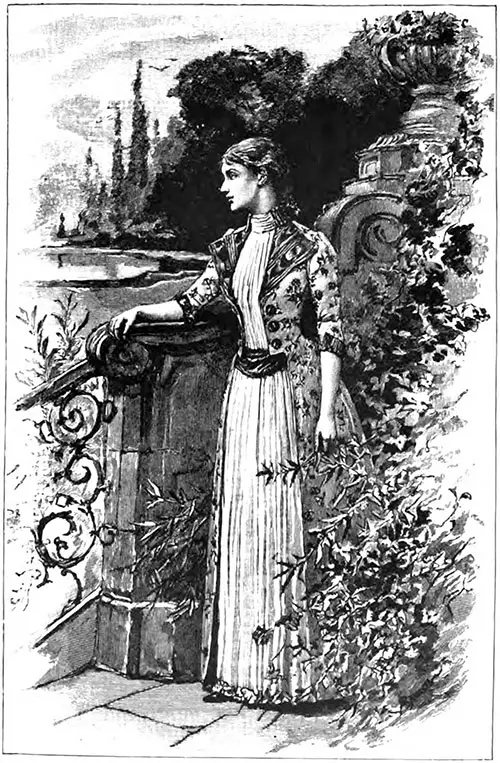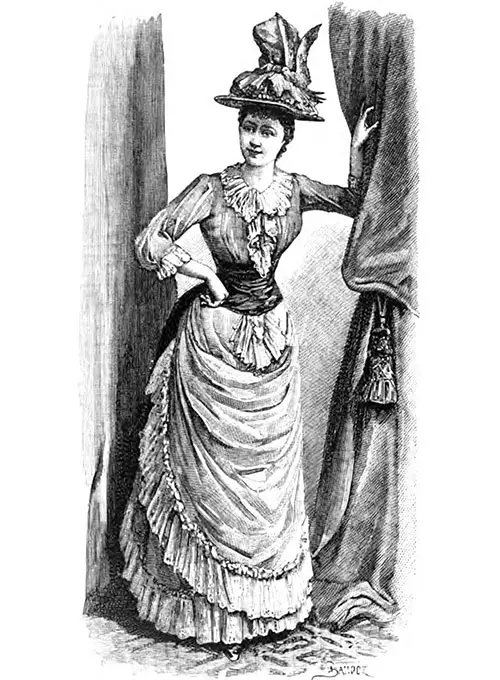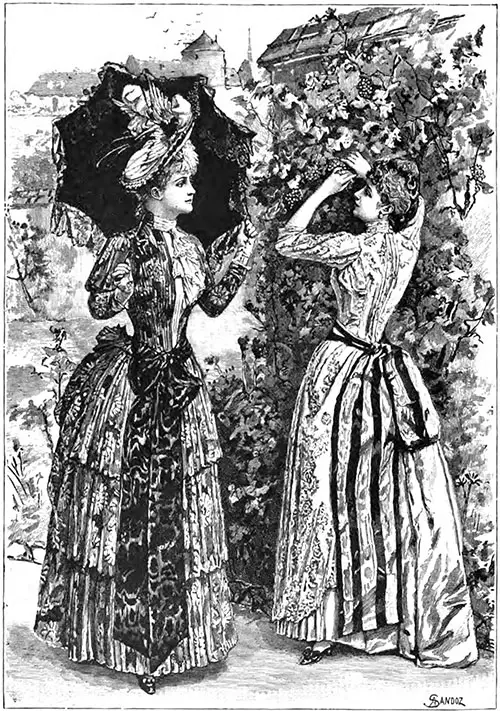Paris Fashions September 1888
The summer is dead, and autumn is upon us. Dress has been a problem of late difficult to solve. The season of the roses proved so damp, so chilly, so treacherous. Its rare hours of sunshine offered no guarantee against wind blowing boisterous as the wind of March from heaven's gate.
The rain was such a constant visitor that the pretty parasols, wreathed with flowers and gay with ribbons, seemed always closed, and austere umbrellas always unfurled. Never did the oldest inhabitant remember such a summer.
Where had July gone to spend the dog-days? Dainty shoulders were shrugged, hands waved in despair at sight of the gowns that had made such a brave show on the jour du Grand Prix, always hanging limp and neglected on pegs in the dress-closet.

Autumn Costume, from the Maison Cély.
Those dresses of Indian foulard and flowered cambric which had made the stands on the race-course appear gay as an animated parterre on that single sunshiny Sunday, were put away sadly.
Soberer tints, warmer stuffs (such as mousseline de laine, veiling, crepon, cloth even) were worn on many summer days, as they will be worn during the autumn.
Grey cloth dresses embroidered in silver, military blue braided in black, white delicately worked in gold, are at once elegant and serviceable gowns, made with jackets completing the costumes.
The jackets are made with revers; the skirts are extremely light and simple. Elaborate trimmings and draperies are discarded. A high pleating bound by a scarf knotted behind, or a long slightly-draped tunic covering the skirt, are now the two styles in vogue for walking-dresses.
The tendency is growing increasingly marked to discard artificial additions (such as bustles, hoops, etc.), and to let the folds fall more naturally, directed by the lines of the figure; dress, in short, promises to become less like some design subtly conceived by the dressmaker, wherein the wearer plays a secondary part.
It would seem as if ultimately the gown will become suited to the wearer, rather than, as it has too often been hitherto, the wearer adapted to the requirements of the gown.
Jerseys also, which were in favor during the moody summer weather, will be in still greater vogue during the hunting season. Less hot and suppler than cloth, the woven stuff is admirably adapted to physical exercise.
Waistcoats of prepared leather, pliant as a glove, molding the figure, are worn with jacket-bodices or with the "redingote Barras." Flannel, because of its lightness and warmth, its soft clinging properties, ranks first in esteem for seaside wear, or for all sorts of open-air life.
Excellence of Flannel
An excellence in flannel is its good dyeing quality. It takes tints at once brilliant and delicate and has that lusterless appearance which makes all wool so much more artistic in effect than silk and other shimmering materials.
The most fashionable flannels are usually white, or cream striped with an assortment of colors — for stripes keep their popularity. At Trouville, Deauville, Dieppe, on all the shores where Parisiennes, weary of town delights, look for more rural pleasures—as in the tree shaded country—they go forth on their quest clad in a material suitable to meet the requirements of the variable early autumn climate.
I saw a flannel dress at the Maison Morin-Blossier which was a model of lightness and elegance. The snow-white ground was striped at wide intervals with narrow blue lines of the shade known as "old-blue," the stripe being bordered with spots of blue and grey.
The dress was made with a long tunic, slightly draped in front, falling in deep pleats, and straight at the back; open on one side, it showed the skirt. The vest-bodice opened over a shirt of pink; the sash was a scarf of old-blue surah.
Another striped flannel dress was of cream-color striped with moss-green and coral-pink. Deep moss green velvet outlined the long tunic to the short basque bodice, which opened, showing a vest of pale coral-pink Indian silk.
The sleeves were surmounted at the shoulder by a high puff of moss-green velvet and finished off with Vandyke cuffs of velvet at the wrists. The back of the skirt fell in full deep pleats; a narrow foot-flounce of pale pink repeated the delicate tones of the pink silk vest.
Grey in all its soft neutral tints is much worn. A voile dress of the verdigris shade was made with a draped tunic brightened at the edge by three bands of flowers embroidered in silk on ecru cambric.
The gathered bodice was trimmed with bands of the same floral embroidery, which gave a delightful gleam of color to the neutral-tinted gown.
Walking Dresses
As walking-dresses are becoming more sensible with the growing tendency to make them simpler and light, gala dresses are less conventional, and more picturesque and varied in style. "Le style Louis XIII" is disputing popularity with "le style Empire.”
Our dressmakers, while giving the distinctive air of their period to these costumes, impart to them at the same time the cachet of the present. "Rien n'est joli comme la mode," remains the motto of our Parisiennes.
Dinner Dress
An effective dinner-dress, which had a delightful suggestion of having been worn by some chatelaine of the time of Louis XIII, was a shimmer of colors and rich embroidery. The gown was of shot Reseda-green and dahlia-red taffetas, worked with white and ecru silk thread.
The front of the skirt was embroidered; pleats formed panels on each side, headed by embroidery; the sash, the deep wrist-bands, and the collar were embroidered.
Also in Louis XIII style was a dress of dead-leaf foulard; the front of the skirt, which was mounted in small gathers, veiled with the delicate grey-brown tinted "frise" guipure. The bodice was a vest of the graceful "De Thou" shape, cut square over a front of guipure, which disclosed a full shirt of frisé foulard.
The sleeves were flat, veiled with guipure, and surmounted at the shoulder with a high puff of frisé foulard matching the shirt. A long sash of plum-colored faille was fastened behind.
A pretty dress, coquettish and elegantly gay, was of white canvas patterned over with flowers of the "old-red'' shade. The skirt was flounced; the tunic, long and lifted on one side with narrow red ribbons, edged with a narrow flounce of embroidered net; the gathered bodice trimmed with embroidered net; the narrow sash of old red satin with flowing ends.
Fashionable Dresses for Autumn
September is the mild month, with chilly mornings and evenings, in which light wool and other soft warm fabrics are the best for ordinary apparel. Satinette, soft and close of texture, is admirably adapted for the opening autumn days.
A satinette dress of the cachemire pattern, on which was a rich medley of sober colors, was made with a gathered bodice; the tunic draped over a deep flounce forming the under-skirt; the watered sash of the color predominating in the pattern.
Gathered bodices and wide sashes are worn at the gatherings round the dinner-table in the country chateaux. Mme. de Morny lately wore a gown that united the freshness of the country and the elegance of Paris.
Over a skirt of ivory faille were placed three flounces of embroidered cambric. The gathered bodice was of embroidered muslin; the sash — a scarf of moss-green surah with flowing ends—was fastened behind.
Another dress, the artful simplicity of which was but another triumph of the dressmaker's skill, was of Sevres porcelain-blue fancy gauze, with long draped tunic entirely covering the skirt; a gold band edged the tunic and gleamed round the throat and about the sleeves.
Décolleté Dresses
Straight collars are very much worn in these country evening reunions. High frills round the throat are not considered smart and natty. They may be worn with cambric gowns, or by very young girls.
Last season at the races, at the Acacias, and at the Hippodrome, some eccentric ladies tried to introduce bodices cut in a point at the back midway down the shoulders, leaving the nape of the neck uncovered.
These décolleté dresses are quite out of place for morning wear but are suitable for country-house dinner-parties. At these reunions, however, there must be no elaborate dress. The charm of the costume de chateau is its pretty simplicity, its suggestion of differing from the elaborate town festive apparel.
The prettiest gowns are of embroidered net, or embroidered cambric, white or ecru, over ivory, pink, or pale blue slips. Flounces cover the skirt, the tunics are short, the bodices gathered; knots of narrow moire or satin ribbon hold back the draperies.
Hats and Headwear

Costume de Campagne, from the Maison Morin Elossief. Hat, from the Maison Virot.
From gowns, let us pass to hats. Hats are assuming vast proportions. Every pretty face seems surrounded by a large aureole. Watteau's shepherdesses wore head-gear modest in comparison with those which our élégantes now affect.
All through the summer protection from the sun, that rarely shone, was pleaded as an excuse for the increasing size of the hats' brims. The approach of winter and the blasts of autumn must, nevertheless, reduce the proportions of these impressive erections.
The most elegant hats are made of net or crepe. Virot has a collection of such hats. One, of pink crepe, might have been copied from a picture of Marie Antoinette, or of one of her fair Court ladies.
On the crown was placed an immense bar of crepe, with scalloped edges. Pink ribbons surrounded the crown and floated behind.
Another was of sky-blue net, the crown veiled with white lace, a bow of net and lace placed in front; at the back a long net scarf, which was to be worn gathered round the throat.
These trimmings of lace and net replace, for country wear, the richer softness of ostrich-feathers, and the conventionality of artificial flowers. The more solid hats are in English or Leghorn straw; these are usually veiled with lace and trimmed with choux of net or ribbon.
A cut white paillasson hat at Virot's was a perfect model of picturesque simplicity. The crown was trimmed with creamy lace and with knots of watered turquoise-blue ribbon.
Another, of Leghorn straw, was veiled and draped with spotted white net, and trimmed with an aigrette of pleated net and of cream watered ribbon.
There was a large hat of paillasson straw, less dainty, but more artistic, I think, than those I have just described, intended for wear with woolen or linen dresses. It was lined with gathered crepe, caught at the edge by bars of black velvet.
On the outside was placed a large chou, of the scarlet of a cock's crest. A smaller hat, of open-worked paillasson straw, was lined with black velvet. The flat crown was bound round with black velvet ribbon, the long ends of which, falling behind, were to be brought round and fastened like bonnet-strings under the chin.
Cloaks and Mantles
The cloak that best harmonizes with these hats is the charming "douillette Louis XVI" The ladies of today, thus attired, seem to have stepped out of the time when Trianon was a royal playground, and the guillotine had not yet played grim havoc on heads Mignons as their own.
The "douillette" is the prettiest of mantles. It is gathered at the shoulders and trimmed at the edge with lace or a thick pinked-out ruché. It is made in shot taffetas, silver-grey, purple shot with lilac, green with pink. Dust falls easily off silk; and if the taffetas be of good quality, a slight shower of rain will not injure it.
The "douillette" therefore is suited for country wear. If the weather be chilly, it is easy to introduce a light layer of flannel between the silk and the lining. The lining is usually of satin of some tender shade—pink lining grey; cream lining chamois, lilac, violet, etc.
Hair Dressing
One word on the arrangement of the hair. It is ruled so much by the fashion of hats and bonnets that, with the large head-gear now in vogue, locks are no longer brushed up to the top of the head, leaving the nape of the neck uncovered.
Noirat, our famous hair-dresser, has once more brought in the fashion of wearing the hair low, fastened by a ribbon just below the nape of the neck.
This fashion is not cumbersome and does not soil the back of the bodice. When winter returns, with its high fur collars and boas, perhaps the hair will once more be brushed up and twisted into classic knots on the top of the head.
Meanwhile there is every sign of the long-abandoned ringlets returning into vogue. It would seem as if once more ladies might wear those floating curls we see in old family pictures. Even now cascades of curls adorn many fair heads in the evening.
These frisures avouables, of which we have heard so much, are sensible additions, put in to spare the twisting with hot irons of natural locks. Nothing destroys the hair so much as submitting it to the pressure of heated pincers.
It is therefore an excellent device, to avowedly spare the hair this unnatural treatment. Wreaths of flowers are coming in, such as our grandmothers wore — delightful chaplets of blossoms, binding the head all round.
In the country, to be worn at dinner, or for evening festivities, garlands are made of natural flowers picked from the garden and conservatory.

Costumes de Chateau, from the Maison Morin-Blossier. Hat, from the Maison Virot.
Stylish Gloves
The question of appropriate gloves to wear with each gown is often a matter of deliberation, and failure in the right selection mars completely the effect of an otherwise successful costume.
Our leaders of fashion now affect long Suede gloves—either light or a medium shade—to wear with both morning and evening dresses, those that are here recognized as Costumes habillées.
The most popular shades are mastic, very pale yellow, light and dark grey, for such colors are not likely, as a rule, to quarrel with those in the dress worn at the time. Russet is likewise a convenient color, for the gant roux, as we term it, looks equally well with a cream gown as with a dark blue or claret one.
Kid gloves are but little worn in colors, but in black they are most popular, because black Suedes are ugly, while black glace kids are decidedly pretty.
Our élégantes sport exceedingly long ones with light muslin and gauze dresses, but then there is either a black hat, a black sash, or throat-ribbon in the costume, or the black gloves would be inharmonious.
For country or seaside morning wear, long kid gloves of very thick quality are in vogue. They are buttonless; and dark yellow or wood-color is more patronized than any other. These gloves are inexpensive and preserve both hand and arm from sea-air and sun.
In all our illustrations (which are sketched from models at the leading Paris houses) it will be remarked that there is a decided alteration in skirts.
Draperies and poufs, so fashionable of late years, have given place to straight pleats or folds, which fall straight from the waist without the intricacies of drapery, never very successful unless achieved by a gifted master-hand.
Johnstone, Violette, “September Fashions: Paris,” in The Woman’s World, Cassell & Company, Limited, London, Paris, New York & Melbourne, Volume I, No. 11, September 1888, p. 525-528.
Editor's Note: Some terminology used in the description of women's clothing during the 1800s and early 1900s has been changed to reflect more modern terms. For example, a women's "Toilette" -- a form of costume or outfit has an entirely different common meaning in the 21st century. Typical terms applied to "toilette" include outfit, ensemble, or costume, depending on context.
Note: We have edited this text to correct grammatical errors and improve word choice to clarify the article for today’s readers. Changes made are typically minor, and we often left passive text “as is.” Those who need to quote the article directly should verify any changes by reviewing the original material.

